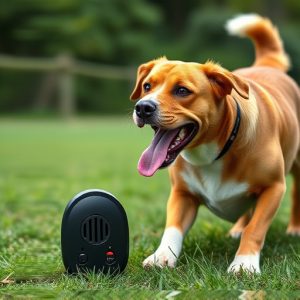Neighborhood Dog Control: Stationary vs. Mobile Repellents Compared
Dog repellent equipment has evolved with stationary and mobile solutions, offering flexible and targ…….
Dog repellent equipment has evolved with stationary and mobile solutions, offering flexible and targeted protection against unwanted canine visits. Stationary devices, powered by electricity, provide consistent protection in specific areas like garden perimeters but lack flexibility. Mobile systems, portable and battery-operated, offer adaptability for temporary measures or fluctuating canine activity, making them ideal for diverse landscapes. Choosing between them depends on coverage area, convenience, budget, and permanent installation feasibility, ensuring neighbors select the most effective method to keep their spaces free from unwanted canine visitors in the Stationary Vs Mobile Dog Repellent Comparison.
Neighborhood dog control is a growing concern, and sonic equipment has emerged as a potential solution. This comprehensive guide delves into the world of dog repellent technology, focusing on stationary and mobile options. We explore their pros, cons, and real-world applications, offering an in-depth analysis to help you make an informed decision. From understanding the principles behind these devices to comparing stationary vs. mobile dog repellents, this article covers all you need to know to choose the best solution for your neighborhood.
- Understanding Dog Repellent Equipment: A Comprehensive Overview
- Stationary Dog Repellents: Pros, Cons, and Real-World Applications
- Mobile Dog Repellents: Portability Meets Effectiveness
- Comparative Analysis: Making an Informed Decision for Your Neighborhood
Understanding Dog Repellent Equipment: A Comprehensive Overview
Dog repellent equipment has evolved significantly, offering both stationary and mobile solutions to address unwanted canine visits. Understanding these options is crucial for effective neighborhood control. The key difference lies in their placement and functionality. Stationary devices are typically installed in specific areas, emitting sounds or scents that deter dogs from entering. These are often powered by electricity and can be triggered manually or automatically through motion sensors. On the other hand, mobile dog repellent systems are portable, allowing for flexible deployment across different locations. They use batteries or alternative power sources to operate, making them ideal for temporary measures during special events or in areas with fluctuating canine activity.
When considering stationary versus mobile options, neighbors should weigh factors like coverage area, convenience, and budget. Stationary devices provide consistent protection for defined spaces but might require more initial setup and maintenance. Mobile systems offer adaptability and ease of use, making them suitable for temporary solutions or areas where permanent installations are not feasible. Both have their merits, and a comprehensive understanding will help neighbors choose the most effective method to keep their areas free from unwanted canine visitors.
Stationary Dog Repellents: Pros, Cons, and Real-World Applications
Stationary dog repellents are designed to deter canine intrusions in specific areas, offering a more consistent and targeted approach compared to mobile alternatives. One of its key advantages is reliability; as the name suggests, these devices remain fixed in one place, ensuring constant protection for designated zones like garden perimeters or entryways. They are ideal for homeowners seeking a reliable solution without the hassle of frequent movement or battery replacement, which is often required with portable models.
However, stationary repellents might not offer the same level of flexibility as mobile options. They require careful placement and may not cover large areas effectively on their own. Additionally, certain weather conditions could impact performance, as outdoor elements might affect the device’s range and effectiveness. Despite these drawbacks, they prove invaluable in scenarios demanding a consistent and specific deterrent, especially when combined with other control methods for a comprehensive solution in the neighborhood dog control sonic equipment debate.
Mobile Dog Repellents: Portability Meets Effectiveness
Mobile dog repellents offer a unique advantage in their portability, allowing for flexible and targeted use. Unlike stationary devices that are permanently installed, mobile options can be easily moved to different areas within a neighborhood, making them ideal for large or diverse landscapes. This adaptability is particularly useful for communities with varied terrain or those looking to deter dogs from specific zones, such as gardens or parks.
When comparing stationary and mobile dog repellents, the latter often provides a more dynamic solution. While stationary devices might be effective in confined spaces, mobile options excel in addressing roaming dog issues across broader areas. Their portability also enables quick responses to changing situations, ensuring that dog owners and neighbors can maintain control over their outdoor spaces effectively.
Comparative Analysis: Making an Informed Decision for Your Neighborhood
When considering solutions for neighborhood dog control, a key decision point is between stationary and mobile dog repellent systems. Both have their merits and demerits, necessitating a thorough analysis before committing. Stationary systems, often more affordable and easier to install, rely on consistent sound emissions to deter dogs. However, they may lack flexibility in terms of coverage area and are limited to fixed locations.
In contrast, mobile dog repellents offer greater versatility, allowing users to move them around to adapt to changing situations or new problem areas. These systems can be more effective in addressing roving dogs that don’t adhere to specific zones. However, they generally carry a higher price point and require ongoing maintenance. A Comparative Analysis is crucial to determine which type aligns best with your neighborhood’s needs, size, and budget, ensuring an informed decision that promotes harmony between residents and their canine neighbors.
In conclusion, both stationary and mobile dog repellent equipment offer unique advantages in neighborhood control. The Stationary Vs Mobile Dog Repellent Comparison highlights that stationary devices are ideal for consistent, long-term deterrence in defined areas, while mobile options provide versatility and portability for dynamic, larger neighborhoods. By considering the pros and cons of each type, residents can make an informed decision to effectively manage canine populations and maintain peaceful living environments.


